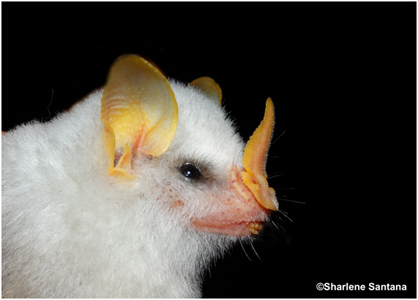Animals cannot synthesize carotenoid pigments de novo, and must consume them in their diet. Most mammals, including humans, are indiscriminate accumulators of carotenoids but inefficiently distribute them to some tissues and organs, such as skin. This limits the potential capacity of these organisms to benefit from the antioxidant and immunostimulatory functions that carotenoids fulfill. Indeed, to date, no mammal has been known to have evolved physiological mechanisms to incorporate and deposit carotenoids in the skin or hair, and mammals have therefore been assumed to rely entirely on other pigments such as melanins to color their integument. Here high-performance liquid chromatography (HPLC) in combination with time-of-flight mass spectrometry (HPLC-TOF/MS) is used to show that the frugivorous Honduran white bat Ectophylla alba colors its skin bright yellow with the deposition of the xanthophyll lutein. The Honduran white bat is thus a mammalian model that may help developing strategies to improve the assimilation of lutein in humans to avoid macular degeneration. This represents a change of paradigm in animal physiology showing that some mammals actually have the capacity to accumulate dietary carotenoids in the integument. In addition, the majority of the lutein in the skin of Honduran white bats is present in esterified form with fatty acids, thereby permitting longer-lasting coloration and suggesting bright color traits may have an overlooked role in the visual communication of bats. informacion[at]ebd.csic.es: Galvan et at (2016) Tropical bat as mammalian model for skin carotenoid metabolism. Proc Natl Acad Sci USA doi: 10.1073/pnas.1609724113
http://www.pnas.org/content/early/2016/09/06/1609724113.abstract.








 Las altas temperaturas están provocando que las lagunas y las marismas de Doñana pierdan agua rápidamente
Las altas temperaturas están provocando que las lagunas y las marismas de Doñana pierdan agua rápidamente



